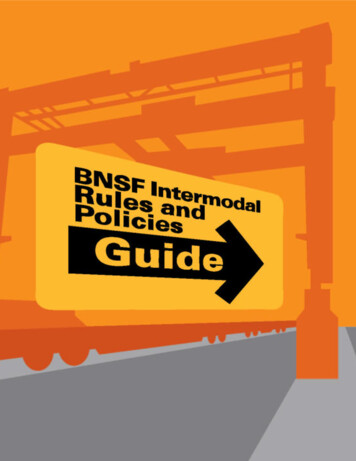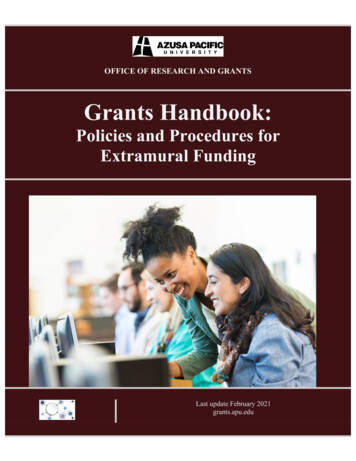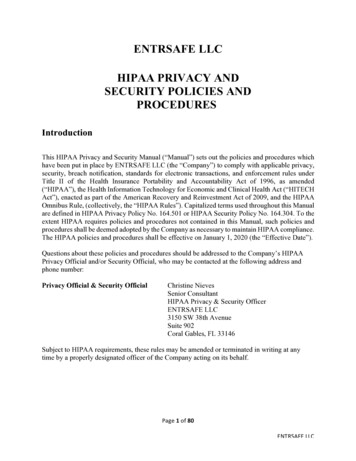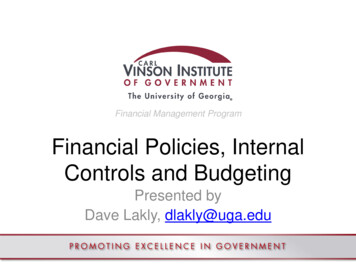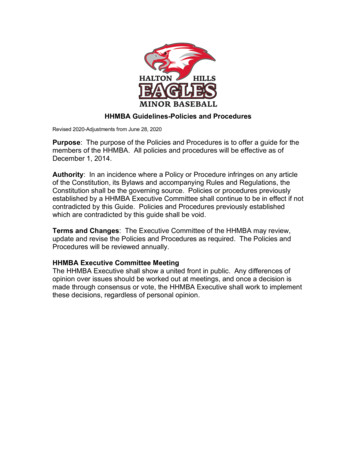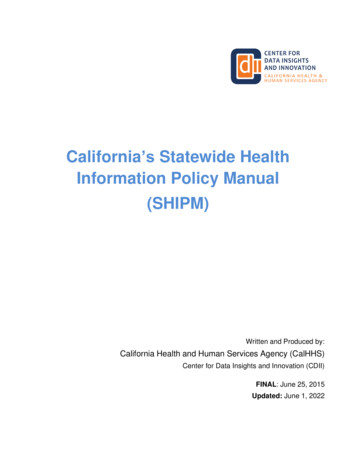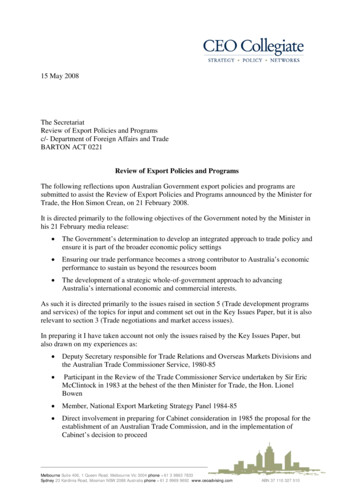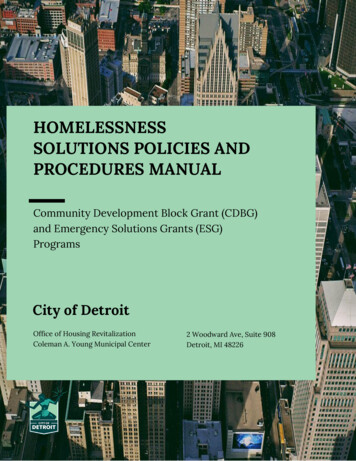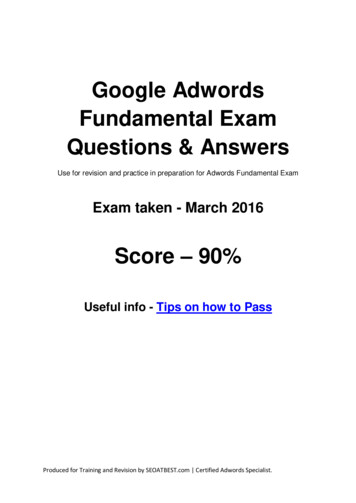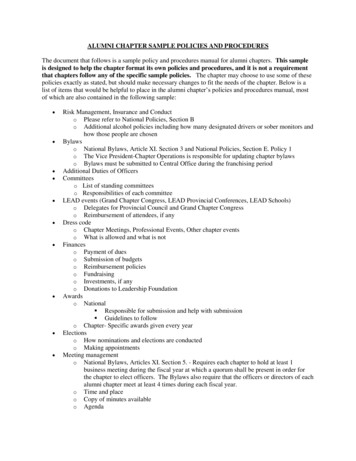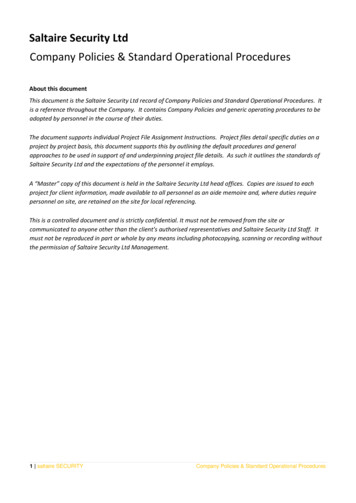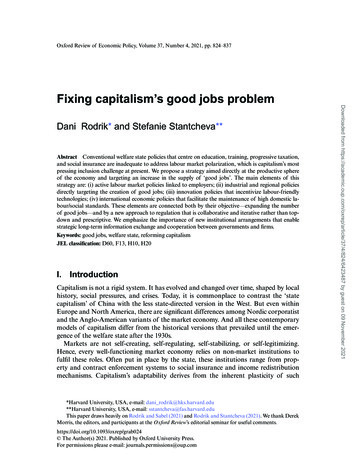
Transcription
SAFE AND SECURE: GUIDES TO CREATING SAFER SCHOOLSSchoolPoliciesandLegalIssuesGUIDE 2Supporting Safe SchoolsNORTHWEST REGIONALEDUCATIONAL LABORATORYSAFE AND DRUG-FREESCHOOLS PROGRAMU.S. DEPARTMENT OFEDUCATIONOFFICE OF JUVENILEJUSTICE AND DELINQUENCYPREVENTIONU.S. DEPARTMENT OF JUSTICE
SAFE AND SECURE: GUIDES TO CREATING SAFER SCHOOLSSchoolPoliciesandLegalIssuesGUIDE 2Supporting Safe SchoolsBy Kirk A. BaileySeptember 2002NORTHWEST REGIONALEDUCATIONAL LABORATORY
NORTHWEST REGIONAL EDUCATIONAL LABORATORYiCONTENTSForeword . . . . . . . . . . . . . . . . . . . . . . . . . . . . . . . . . . . . . . . . . . . . . . . . . . . . . . . . . . . . . . . . . . . . . . . . . . . . . . . . . . . . . . . . . .iiiIntroduction . . . . . . . . . . . . . . . . . . . . . . . . . . . . . . . . . . . . . . . . . . . . . . . . . . . . . . . . . . . . . . . . . . . . . . . . . . . . . . . . . . . . . . . .1Section 1. Developing District Policies on Violence . . . . . . . . . . . . . . . . . . . . . . . . . . . . . . . . . . . . . . . . . . . . . . . . . . . .3Section 2. Specific Policy and Legal Components . . . . . . . . . . . . . . . . . . . . . . . . . . . . . . . . . . . . . . . . . . . . . . . . . . . . . . .9Conclusion . . . . . . . . . . . . . . . . . . . . . . . . . . . . . . . . . . . . . . . . . . . . . . . . . . . . . . . . . . . . . . . . . . . . . . . . . . . . . . . . . . . . . . . .27Endnotes . . . . . . . . . . . . . . . . . . . . . . . . . . . . . . . . . . . . . . . . . . . . . . . . . . . . . . . . . . . . . . . . . . . . . . . . . . . . . . . . . . . . . . . . .29Resources . . . . . . . . . . . . . . . . . . . . . . . . . . . . . . . . . . . . . . . . . . . . . . . . . . . . . . . . . . . . . . . . . . . . . . . . . . . . . . . . . . . . . . . .37
NORTHWEST REGIONAL EDUCATIONAL LABORATORYiiiFOREWORDSchool safety requires a broad-based effort by the entire community, including educators, students, parents,law enforcement agencies, businesses, and faith-based organizations, among others. By adopting a comprehensive approach to addressing school safety focusing on prevention, intervention, and response, schoolscan increase the safety and security of students.To assist schools in their safety efforts, the Northwest Regional Educational Laboratory (NWREL) hasdeveloped a series of eight guidebooks intended to build a foundation of information that will assist schoolsand school districts in developing safe learning environments. NWREL has identified several componentsthat, when effectively addressed, provide schools with the foundation and building blocks needed to ensurea safe learning environment. These technical assistance guides, written in collaboration with leading nationalexperts, will provide local school districts with information and resources that support comprehensive safeschool planning efforts.One objective of the guides is to foster a sense of community and connection among schools and thoseorganizations and agencies that work together to enhance and sustain safe learning environments. Anotherobjective is to increase awareness of current themes and concerns in the area of safe schools.Each guide provides administrators and classroom practitioners with a glimpse of how fellow educatorsare addressing issues, overcoming obstacles, and attaining success in key areas of school safety. Theseguidebooks will assist educators in obtaining current, reliable, and useful information on topics that shouldbe considered as they develop safe school strategies and positive learning environments.Each of the guidebooks should be viewed as one component of a school’s overall effort to create a saferlearning environment. As emphasized in Threat Assessment in Schools: A Guide to Managing Threatening Situations and to Creating Safe School Climates, a joint publication of the U.S. Secret Service and the U.S. Department of Education, creating cultures and climates of safety is essential to the prevention of violence in school.Each guidebook contains this message as a fundamental concept.Under No Child Left Behind, the education law signed in January 2002, violence prevention programs mustmeet specified principles of effectiveness and be grounded in scientifically based research that providesevidence that the program to be used will reduce violence and illegal drug use. Building on the concept inNo Child Left Behind—that all children need a safe environment in which to learn and achieve—these guidesexplain the importance of selecting research-based programs and strategies. The guides also outline a sample of methods on how to address and solve issues schools may encounter in their efforts to create andenhance safe learning environments.Guide 1: Creating Schoolwide Prevention and Intervention Strategies, by Jeffrey Sprague and HillWalker, is intended to put the issue of schoolwide violence prevention in context for educators and outlinean approach for choosing and creating effective prevention programs. The guide covers the following topics: Why schoolwide prevention strategies are critical Characteristics of a safe school Four sources of vulnerability to school violence How to plan for strategies that meet school safety needs Five effective response strategies Useful Web and print resourcesGuide 2: School Policies and Legal Issues Supporting Safe Schools, by Kirk Bailey, is a practicalguide to the development and implementation of school policies that support safe schools. Section 1 providesan overview of guiding principles to keep in mind when developing policies at the district level to prevent violence. Section 2 addresses specific policy and legal components that relate to such topics as discipline anddue process, threats of violence, suspension and expulsion, zero tolerance, and dress codes. Checklists areincluded to ensure that schools attend to due process when developing policies for suspensions or expulsions,search and seizure, or general liability issues.
ivSchool Policies and Legal Issues Supporting Safe SchoolsGuide 3: Implementing Ongoing Staff Development To Enhance Safe Schools, by Steve Kimberlingand Cyril Wantland, discusses the role of staff development within the context of school safety. The guideaddresses how staff development should be an integral part of the educational planning process and discusses what its relationship is to safety-related outcomes and overall student achievement.Guide 4: Ensuring Quality School Facilities and Security Technologies, by Tod Schneider, is intendedto help educators and other members of the community understand the relationship between school safetyand school facilities, including technology. The guide covers the following topics: Crime Prevention Through Environmental Design (CPTED) Planning To Address CPTED: Key Questions To Ask Security Technology: An Overview Safety Audits and Security SurveysGuide 5: Fostering School-Law Enforcement Partnerships, by Anne Atkinson is a practical guide to thedevelopment and implementation of partnerships between schools and law enforcement agencies. Section 1provides an overview of community policing and its relationship to school effectiveness. Section 2 focuses ondeveloping the school-law enforcement partnership from an interagency perspective. Section 3 focuses onsteps for implementing school–law enforcement partnerships in schools. Also included are descriptions ofthe roles of law enforcement in schools with examples of many strategies used to make schools safer andmore effective.Guide 6: Instituting School-Based Links With Mental Health and Social Service Agencies, byDavid Osher and Sandra Keenan, discusses how schools can improve their capacity to serve all students bylinking with mental health and social service agencies. Agency staff members can contribute to individual andschoolwide assessment, planning, implementation, and evaluation. Agency resources can enhance schools’capacity to provide universal, early, and intensive interventions. Links with agency resources can also alignschool and agency services.Guide 7: Fostering School, Family, and Community Involvement, by Howard Adelman and Linda Taylor, provides an overview of the nature and scope of collaboration, explores barriers to effectively workingtogether, and discusses the processes of establishing and sustaining the work. It also reviews the state of theart of collaboration around the country, the importance of data, and some issues related to sharing information.Guide 8: Acquiring and Utilizing Resources To Enhance and Sustain a Safe Learning Environment, by Mary Grenz Jalloh and Kathleen Schmalz, provides practical information on a spectrum of resourcesthat concerned individuals and organizations can use in the quest to create safe schools. It draws on published research and also includes interviews with experts working on school safety issues at the state andlocal levels. Major topics covered include: What are resources? What role do resources play in safe school planning? Identifying and accessing resources Appendix of online and print resources—Northwest Regional Educational Laboratory
NORTHWEST REGIONAL EDUCATIONAL LABORATORY1INTRODUCTIONThe law isn’t justice. It’s a very imperfect mechanism. If you press exactly the right buttons and are also lucky,justice may show up in the answer. A mechanism is all the law was ever intended to be.—Raymond Chandler (1888–1959), American authorSound school policy development plays an essential role as a violence prevention and control tool. By anticipating safety problems and actively addressing them, schools increase their ability to avoid or respond to acrisis. Clearly articulated rules and policies, established through community involvement and implementedfairly, will provide a solid foundation for a comprehensive approach to school safety.A comprehensive approach to school safety involves meeting challenges on several fronts. Administrativesupport is essential to provide the necessary resources for violence prevention efforts. Careful planning andvigilant monitoring are required to ensure the security of the school facility. Schoolwide education and training about safety prepare students to take careful action to avoid becoming either perpetrators or victims ofviolence. Violent students must be removed and, if possible, directed toward more positive behavior so thatthe safety of other students and staff is ensured. Involvement of parents and other concerned communitymembers provides essential resources and support.In the course of these activities, teachers and school leaders will face important legal questions thataffect many lives. These questions center on issues involving privacy and school records, discipline and dueprocess (including zero tolerance policies), search and seizure, dress codes, security measures and schoolresource officers, and general liability issues. When appropriate measures are taken in all these areas, therisk of violence at school (or the effects of aftermath of violence) will be minimized. Clear and consistentpolices, developed proactively by school officials, teachers, and parents, will establish student expectationsand promote a stable school setting, leading to a safe educational environment.At the same time, the philosophical outlook of any youth violence prevention effort is important to theresults that are anticipated. In other words, even while developing school policies and meeting legal requirements, schools, parents, teachers, and communities will reap what they sow. Policies set the tone of schooladministration and shape the culture of each classroom, school, and school district. Accordingly, while it isimportant to focus on the legal implications and issues of school safety efforts, this must be balanced by astrong sense of fairness and concern for the dignity and integrity of every member of the school community.Excessive attention to wrongdoing, potential lawsuits, and the minutiae of legal requirements—the paperwork, hearings, and compliance—may ultimately detract from the creative effort to build a more peacefulschool. Such an approach risks being overly concerned with blame, punishment, and legal wrangling.Ultimately, a more secure school will grow from the sense of integrity, fairness, justice, and cooperativeeffort exhibited by school principals, teachers, and others in positions of leadership. Allowing youth to learnthat justice is never about the effort to exact punishment and retribution, but rather that true justice is aboutworking to repair a safe and secure vision for their school and creating healing, restoration, and peace, willbuild their sense of values, personal integrity, and accountability to the larger community. Involving studentsin the planning and policy development process presents a unique and wonderful teaching moment.In the end, policies and law are only guideposts for human activity, and cannot substitute for its basichumanity. This humanity requires each of us to engage our common sense, common compassion, and common creativity to build a more secure environment for student learning.
2School Policies and Legal Issues Supporting Safe SchoolsUsing This GuidebookThis publication is intended to serve as a practical guide to the development and implementation of schoolpolicies that support safe schools. It also may be helpful as a training resource.Section 1 provides an overview of guiding principles to keep in mind when developing policies at the district level to prevent violence. Section 2 addresses specific policy and legal components that relate to suchtopics as discipline and due process, threats of violence, suspension and expulsion, zero tolerance, and dresscodes. Checklists are included to ensure that schools attend to due process when developing policies forsuspensions or expulsions, search and seizure, or general liability issues.The Resources section includes a list of agencies and organizations that may be able to provide moreinformation or assistance regarding school policies and legal issues related to safe school planning.A word on scope: Throughout this document “school officials” refers to school administrative personnel,such as principals, assistant principals, secretaries, counselors, board members, and so forth, in both regularand alternative education school settings, unless otherwise noted in the text. Moreover, standards outlined inthis document are general standards for any school environment and are not delineated by regular, alternativeeducation, or special education settings. While procedures and legal requirements are often different in eachof these settings, the scope of such issues simply exceeded the allowable size of this publication. Therefore,unless otherwise indicated these standards and recommendations apply equally in each circumstance.
NORTHWEST REGIONAL EDUCATIONAL LABORATORYSECTION 1DEVELOPINGDISTRICT POLICIESON VIOLENCE3
NORTHWEST REGIONAL EDUCATIONAL LABORATORY5Many important points need to be considered in developing school district policies and addressing the legalissues related to school safety and youth violence. Schools officials need to consider the process for developing such policies, implement and maintain that process, ensure consistency with state law and local regulations, incorporate best practices whenever possible, and ensure the reasonableness and practicality of thepolicies. Because most schools have policy processes already in place, this section will focus on a few guidingprinciples.In general, school policymaking should ensure that disciplinary and safety rules are: Directed toward an identified and legitimate safety, discipline, or education goal or mission Consistent with constitutional and statutory standards Within the school’s authority Articulated, clear, and consistent Nondiscriminatory Properly adopted Publicized and disseminated Consistently applied Supported by the community Properly enforced 1Best PracticesPerhaps one of the most important elements of developing district policies is ensuring they are effective anddraw on best practices in the field. Research and development, government programs, and the work of schoolsthroughout the nation have led to an ever-increasing store of knowledge regarding school safety plans, violence policies, and promising prevention and intervention programs. In many areas, state school safety centers have been established to assist local school districts. Numerous national associations and centers thatpublish model programs and policies for schools augment these efforts. A listing of some resources in thisarea is included in the Resources section of this publication. By drawing on best practices, schools demonstrate that their policies are well thought out, comprehensive, and reasonable, which strengthens their position should legal challenges or issues arise.NondiscriminatoryThe importance of this issue deserves some elaboration. School policies may have discriminatory impacts inseveral situations, including disciplinary procedures, suspension and expulsion, special education services,and the provision of counseling or health services.Generally, all individuals must be afforded equal enjoyment of fundamental rights.2 The protection of equalenjoyment requires that individuals affected by school policies be treated uniformly; in other words, that therights, privileges, or responsibilities imposed on an identified segment of the population apply equally to allmembers of that group.3 This does not mean pure or absolute equality; rather, it requires that governmentclassifications stand on reasonable grounds.4 What constitutes reasonable grounds will depend on whetherthe classification or government action affects a fundamental right or an “inherently suspect” group. Wherestate action infringes on a fundamental right or impacts an “inherently suspect group, a school’s actions mustbe narrowly tailored to achieve a compelling state interest.”5 An “inherently suspect” group has traditionallybeen defined as a “discrete and insular minority” subject to “invidious discrimination” and is commonlyunderstood to include racial minorities and ethnic groups.6 There are almost no circumstances under whichsuch a classification can be argued to be a narrowly tailored attempt at achieving a compelling governmentinterest.
6School Policies and Legal Issues Supporting Safe SchoolsIt has been long been believed that the government has a compelling interest in ensuring a strong systemof education, necessarily implying it is free of violence. In Brown v. Board of Education (1954), the SupremeCourt observed:Education is perhaps the most important function of state and local governments . It is a principal instrument in awakening the child to cultural values, in preparing him for later professionaltraining, and in helping him to adjust normally to his environment . It is doubtful that any childmay reasonably be expected to succeed in life if he is denied the opportunity of an education.7For this reason, school officials have a strong obligation, both moral and legal, to take action in dealing withundisciplined youths, who may potentially threaten the welfare and safety of the other children in attendance.School safety, however, is probably not a compelling enough interest to select youth for attention by prevention or intervention programs based on race. Race-based classifications are upheld only in situationsdesigned to remediate past discrimination, such as in college admissions (and even this purpose is underserious question). Maintaining school security is critically important to the well-being of young people, butprobably not so important as to justify race-based classifications to maintain order. In fact, such methods inschools would run counter to decades of judicial interpretations and development of social norms explicitlyaimed at removing race-based classifications from all aspects of education. To insert such considerationsback into the educational environment would play to the worst instincts and base assumptions about violencein America.In contrast, where neither a fundamental right nor a “discrete and insular minority” is involved, a school’sactions will be valid provided they rest on some rational basis, meaning that it is reasonably related to achieving a legitimate state purpose.8 In this case, it is not necessary for the state to utilize the best possible methods to achieve its goals; rather, all that is required is that the methods actually used be reasonable.9ReasonablenessGenerally, school districts will be required to adopt policies that are reasonably designed to address whatever problem they face. The reasonableness standard requires that school officials balance the need to makethe school environment safe and maintain order and control with the student’s interest in privacy, access toeducation, and autonomy. Schools should then design policies that match the problem in scope.In other words, a school safety policy must bear some rational relationship to the problem it attempts tosolve. For example, metal detectors clearly offer a rational and reasonable method of locating weapons in aschool. However, cameras placed in boys and girls locker rooms to monitor potential drug sales may not bereasonable when students rightly expect some degree of privacy and the problem might be addressed just aseasily by the presence of coaches, monitors, or other school officials.In addition, while reasonable for a school to share disciplinary records with local police, it is probably notreasonable to share a student’s school records showing poor attendance, unsatisfactory academic performance, and low income levels as part of a profile of potentially antisocial kids. Moreover, while reasonable toexpel a student for bringing a handgun to school, it is not reasonable to expel that same student for writing astory about bringing a handgun to school for a classroom creative writing project.Fortunately, the reasonableness standard offers a great deal of latitude for school policymakers. Mostconceivable school safety efforts will be rationally related to preventing violence, intercepting weapons,responding to antisocial behavior, and prohibiting drug use or theft. School safety and violence preventionpolicies and plans will be upheld by the legal system in most cases, provided they meet this standard.Consequently, so long as schools guarantee that students are treated uniformly by school policies regardless of race, gender, ethnicity, or religion and follow the proper due process procedures when discipliningstudents, they are unlikely to violate legal protections against discrimination.
NORTHWEST REGIONAL EDUCATIONAL LABORATORY7A Catch-22: Are Schools Stuck Between a Rock and a Hard Place?Comprehensive school safety plans are an integral part of school management, yet the decision to adopt andimplement a plan may not protect a school from potential liability. More discussion of general liability followsin a later section, but for introductory purposes it is important to note a school may be held to a greater standard to ensure supervision and safety where it adopts a school safety plan. Courts have held schools liablein such circumstances under the belief that where a school increases efforts to curb violence, it assumes agreater duty to supervise students and persons on school grounds in part because people rely on the provisions of the plan to protect them.10The opposite, and more common situation, is true as well. In light of current youth violence levels, liabilitywill be asserted more often where a school fails to provide a school safety plan. Ultimately, a school’s responsibility rests on whether the act of violence was foreseeable and on an assessment of the school’s duty tomaintain a safe environment under the circumstances. Consequently, the existence or absence of a schoolsafety plan will not be the only determining factor regarding a school’s liability. The simplest and best policy,then, is for schools to develop realistic plans as part of an effort to protect students and teachers alike fromviolent acts.Publication/Dissemination of School Conduct Codes (“Getting the Word Out”)Of course, a school safety plan and conduct code is only effective if students, teachers, and parents are awareof it. Schools are advised to make every effort to ensure students and parents are aware of the existence of aschool safety plan and are familiar with the provisions of the school conduct code. To this end, schools mightask both students and parents to sign forms stating they have read the school conduct code as a part of schoolprocedures related to student enrollment, participation in extracurricular activities, or notification of grades.In addition, teachers may find appropriate opportunities to reference the school conduct code or safety planas a part of parent–teacher conferences. Moreover, schools would benefit from frequent references andoverviews of the school safety plan in board meetings, school newsletters, or other outreach efforts to parents,students, and the community. While no specific measures are required of schools in this regard, any effort tocertify that students and parents are aware of the school’s safety plans will heighten awareness and enhancethe security of the school.The following pages provide some additional discussion of key policy areas and legal issues to aid schoolefforts.
NORTHWEST REGIONAL EDUCATIONAL LABORATORYSECTION 2SPECIFIC POLICY ANDLEGAL COMPONENTS9
NORTHWEST REGIONAL EDUCATIONAL LABORATORY11Student discipline may take many forms, from a simple rebuke to expulsion from school. Generally, schoolshave great flexibility to determine and establish disciplinary methods, provided they are consistent with localcommunity values and are not shocking to constitutional standards such as due process, equal protection, freespeech, and freedom from discrimination based on race, religion, gender, disability, or national origin. Schoolsmay implement almost any reasonable method of discipline provided it is directed at controlling, training, oreducating students. Schools should endeavor to ensure their methods are not capricious, oppressive, arbitrary, or contrary to law.Most disciplinary methods employed by schools are considered valid and draw little attention from courts.Typical disciplinary methods include detention, time out or isolation, alternative education programs, denialof participation in school activities, and verbal reprimand or chastisement.Moreover, a student generally may be disciplined for off-campus conduct if school authorities can showthat the student’s actions have a direct and immediate effect on either school discipline or the safety andwelfare of students and staff.11 Usually, if the off-campus activity involves two or more students from the sameschool then a sufficient connection will be established to warrant school discipline. However, this type ofdirect connection is not required.The following pages provide guidelines for instituting specific disciplinary actions.Threats of ViolenceDisciplinary actions may be taken simply for the threat of harm to another person. Students sometimes willthreaten to hurt fellow students out of frustration, fear, or a genuine intent to harm. Threats may take severalforms including direct threats (“I’m going to kill you”), indirect threats (“If I wanted to I could blow the schoolup”), veiled threats (“If you want to settle this, let’s go outside”), or conditional threats (“If I don’t get out ofdetention, I’m going to cut you”). Schools may discipline a student for a threat if it can reasonably be inferredthat the threat is a serious expression of intent to harm or assault another person.12 A student may be punishedwhere he or she has “directly and unambiguously threatened physical harm” to a fellow student or teacher.13Accordingly, students’ speech rights may be limited where they infringe on the rights of others to be secureand left alone, such as disrupting classwork, causing substantial disorder, or invading the personal rights ofothers.14 Students have been appropriately disciplined for voicing threats of violence in a variety of circumstances, including: Threatening to shoot a high school guidance counselor if a class schedule was not changed15 Threatening to rape a teacher and the teacher’s daughter and bragging to other students about thethreats16 Verbally assaulting school officials and using “veiled threats” after an erroneous identification of a gunin a student’s car17School conduct codes should clearly identify the behavior related to threats that could result in discipline.This will provide teachers, students, and parents with an enforceable understanding of the appropriateconduct in school.Suspension, Expulsion, and Zero Tolerance PoliciesPerhaps the most significant disciplinary issue currently faced by schools are suspension and expulsion penalties under zero tolerance policies. In light of the state’s clear responsibility to ensure the safety of teachersand students, school officials may expect zero tolerance sanctions to survive legal challenges so long as theschool guarantees the student the necessary due process protections. Such policies are not a violation ofstate compulsory education laws.18 Schools may ban weapons and impose suspension or expulsion for possessing a weapon, but should exercise discretion in other circumstances.
12School Policies and Legal Issues Supporting Safe SchoolsFederal zero tolerance policies generally require mandatory suspension or expulsion for students caughtpossessing a weapon. Increasingly, students have been suspended or expelled for incidents not involvingfirearms or weapons, such as engaging in violent behavior or using/possessing drugs, including: Bringing a gun, owned by a student’s police officer father, to school for show and tell19 Pointing a finger at another student and say
ations and to Creating Safe School Climates, a joint publication of the U.S. Secret Service and the U.S. Depart-ment of Education, creating cultures and climates of safety is essential to the prevention of viol
